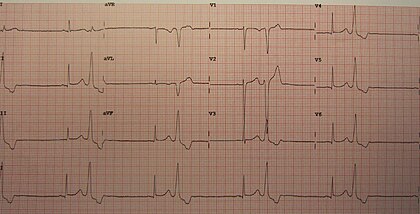| Bigeminy | |
|---|---|
| Other names | Bigemini |
 | |
| Ventricular bigeminy seen on a 12 lead ECG | |
| Pronunciation |
|
| Symptoms | None, feeling of skipped beats[1][2] |
| Complications | Ventricular tachycardia[3] |
| Types | Ventricular, junctional, atrial[4] |
| Risk factors | Stimulants (stress, caffeine, cocaine); alcohol; high thyroid; low oxygen (coronary artery disease, pulmonary embolism, drowning); low potassium; digoxin toxicity; mitral valve prolapse; myocarditis[4][5] |
| Diagnostic method | ECG[6] |
| Differential diagnosis | Trigeminy, second degree heart block[6][3] |
| Treatment | None, beta-blockers, calcium channel blockers, catheter ablation[5] |
| Prognosis | Generally good[2] |
| Frequency | Relatively common[3] |
Bigeminy is a heart arrhythmia in which, following each regular heartbeat, there is a single ectopic beat (irregular heartbeat).[7] There are three types ventricular, junctional, and atrial.[4] Generally there are no significant symptoms; though, there may be feelings of a skipped beat.[1][2] Rarely, low blood pressure and lightheadedness may occur.[8]
Causes include stimulants (psychological stress, caffeine, cocaine); alcohol; high thyroid; low oxygen (coronary artery disease, pulmonary embolism, drowning); low potassium; digoxin toxicity; mitral valve prolapse; and myocarditis.[4][5] Diagnosis is by 12-lead electrocardiogram (ECG).[6] In ventricular bigeminy, each sinus beat is followed by a premature ventricular contraction (PVC), than a pause, another normal beat, and then another PVC.[9][10] In atrial and junctional bigeminy, the second beat is a premature atrial contraction (PAC) or premature junctional contraction respectively.[4]
Outcomes are similar to that of PVCs.[1] If there are more than six PVCs per minute, which is the case in bigeminy, investigations should be performed looking for an underlying cause.[4] Those without symptoms do not generally require specific treatment; otherwise, beta-blockers, calcium channel blockers, or catheter ablation may be carried out.[5] Outcomes are generally good; though, occasionally ventricular tachycardia can occur.[3][2] Bigeminy is relatively common.[3]
References
edit- ^ a b c Manolis, Antonis (March 2024). "Premature ventricular complexes: Clinical presentation and diagnostic evaluation". www.uptodate.com. UpToDate. Archived from the original on 26 October 2023. Retrieved 22 April 2024.
- ^ a b c d Levine, Glenn N. (30 June 2013). Arrhythmias 101. JP Medical Ltd. p. 79. ISBN 978-93-5090-499-2. Archived from the original on 23 April 2024. Retrieved 22 April 2024.
- ^ a b c d e Wang, K; Asinger, RW; Marriott, HJ (April 2007). "Bigeminal rhythms, common and uncommon mechanisms". Journal of electrocardiology. 40 (2): 135–8. doi:10.1016/j.jelectrocard.2006.04.005. PMID 17070536.
- ^ a b c d e f Dubin, Dale (2000). Rapid Interpretation of EKG's: An Interactive Course. Cover Publishing Company. p. 123-139. ISBN 978-0-912912-06-6. Archived from the original on 2024-04-23. Retrieved 22 April 2024.
- ^ a b c d "Bigeminy: Causes, Symptoms & Treatment". Cleveland Clinic. Archived from the original on 18 March 2023. Retrieved 22 April 2024.
- ^ a b c Farzam, K; Richards, JR (January 2024). "Premature Ventricular Contraction". StatPearls. PMID 30422584.
- ^ Hebbar, AK; Hueston, WJ (15 June 2002). "Management of common arrhythmias: Part II. Ventricular arrhythmias and arrhythmias in special populations". American family physician. 65 (12): 2491–6. PMID 12086238. Archived from the original on 24 September 2023. Retrieved 22 April 2024.
- ^ Benditt, David (March 2024). "Syncope in adults: Epidemiology, pathogenesis, and etiologies". www.uptodate.com. UpToDate. Archived from the original on 23 April 2024. Retrieved 22 April 2024.
- ^ Shvilkin, Ary L. Goldberger, Zachary D. Goldberger, Alexei (2013). Goldberger's Clinical Electrocardiography: A Simplified Approach (8th ed.). Philadelphia, PA: Elsevier/Saunders. ISBN 9780323087865.
{{cite book}}: CS1 maint: multiple names: authors list (link) - ^ Mond, HG; Haqqani, HM (July 2020). "The Electrocardiographic Footprints of Ventricular Ectopy". Heart, lung & circulation. 29 (7): 988–999. doi:10.1016/j.hlc.2020.01.002. PMID 32063472.